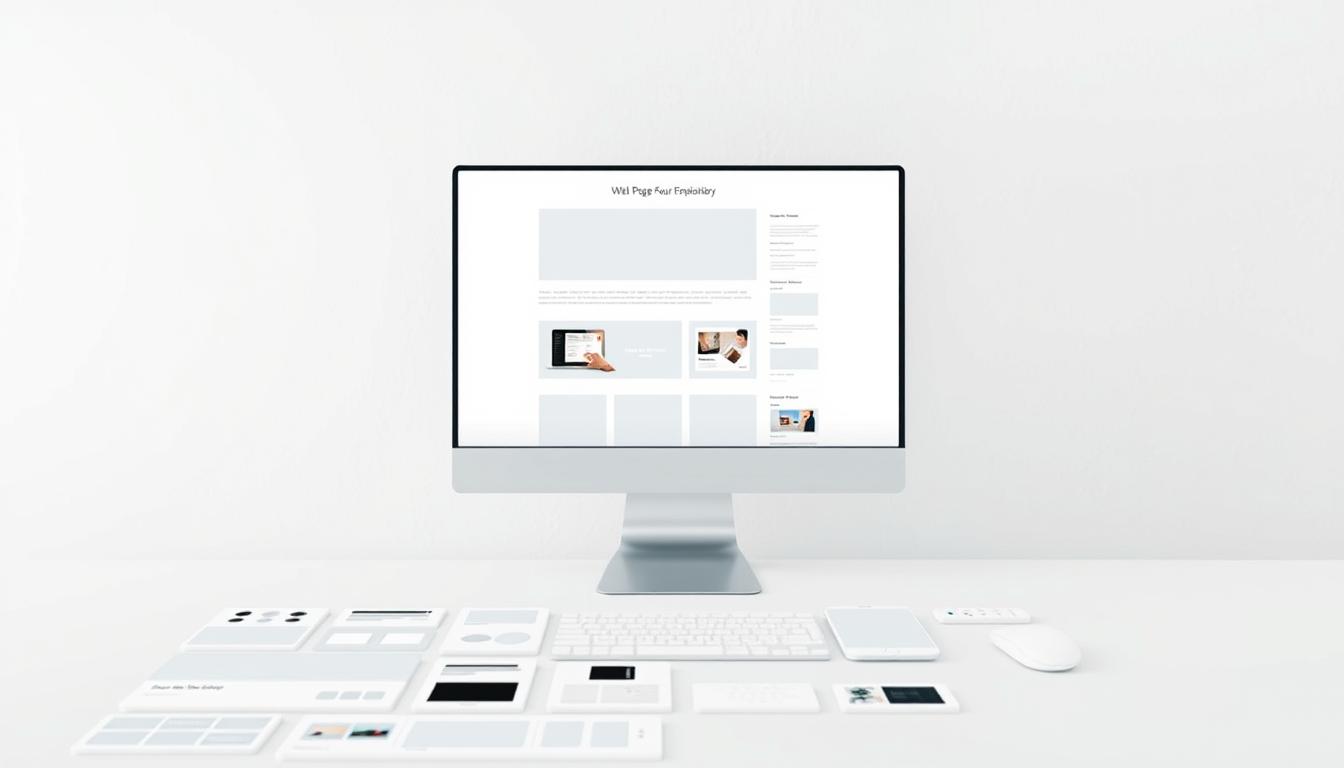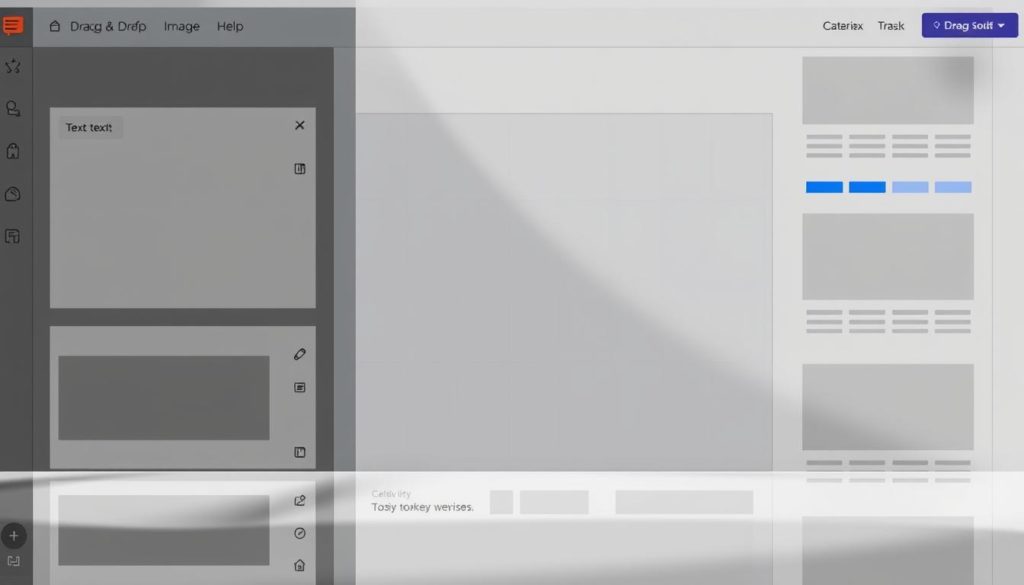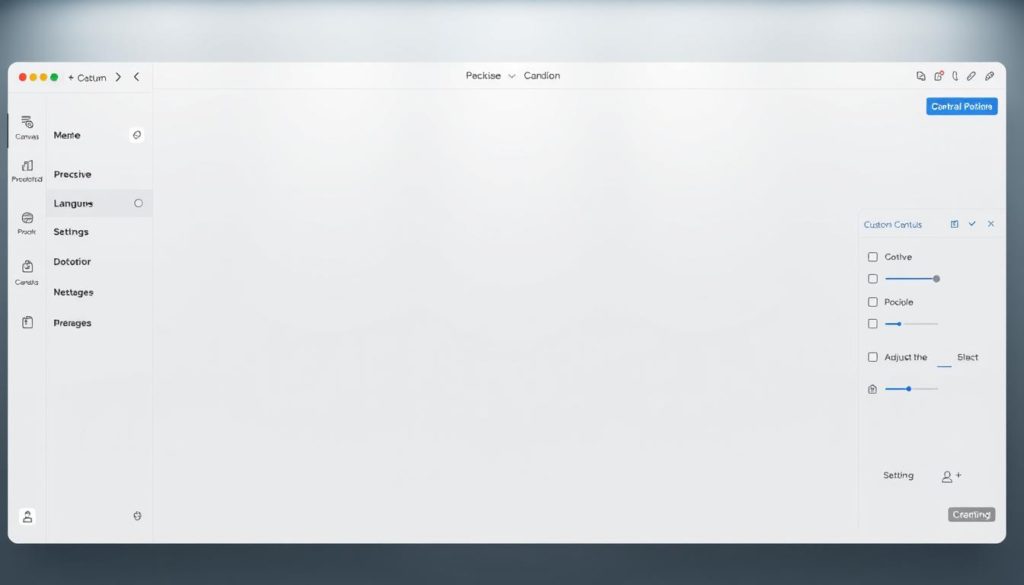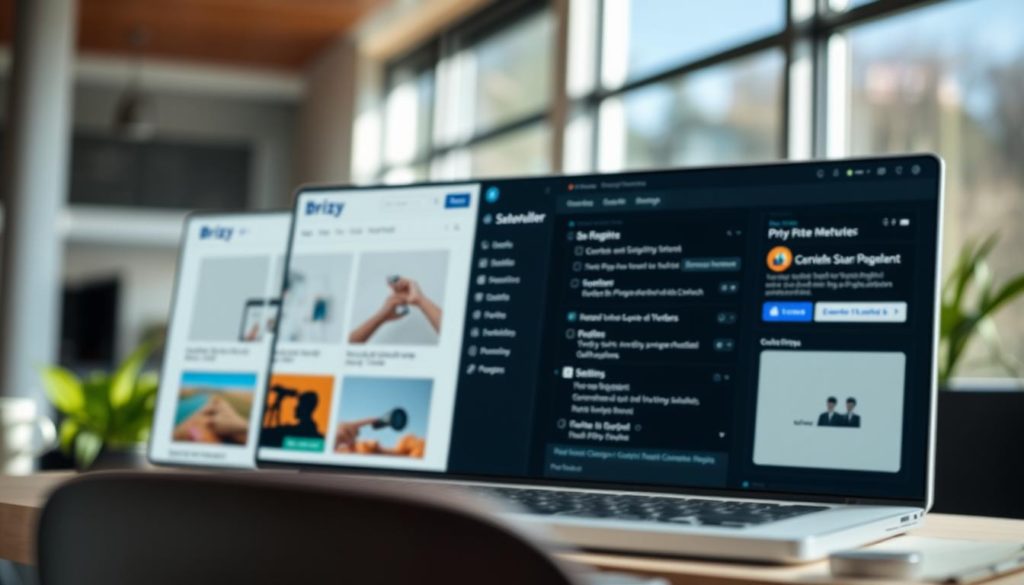
What if you could design a professional website without writing a single line of code? Modern visual tools have transformed how businesses and creators build their online presence. Gone are the days when custom designs required hours of technical work or expensive developers.
Drag-and-drop editors now empower users to craft polished sites in minutes. These platforms blend flexibility with efficiency, letting anyone create layouts that match their vision. But with so many options available, how do you choose the right solution for your needs?
Premium tools offer advanced features like responsive design controls and pre-built templates. They often outperform free alternatives in speed, support, and customization depth. Our analysis compares top-rated plugins based on real-world testing and user feedback.
Key Takeaways
- Visual editors simplify website creation for non-technical users
- Premium solutions provide better support and advanced features
- Template libraries save time while maintaining professional quality
- Performance impacts user experience and search rankings
- Regular updates ensure compatibility with new WordPress features
This guide breaks down what makes certain tools stand out in a crowded market. We’ll explore pricing models, unique capabilities, and hidden costs to watch for. By the end, you’ll know exactly which platform aligns with your project’s scale and goals.
Introduction to Paid WordPress Page Builders
A decade ago, crafting a website required technical skills most business owners didn’t possess. Developers spent hours writing HTML and CSS code just to adjust basic layouts. Customizing themes felt like solving a puzzle with missing pieces.
From Code Editors to Visual Freedom
Early website creation demanded programming expertise for even simple changes. Font adjustments or image placement became time-consuming tasks. This technical barrier kept many from expressing their brand’s true potential through their online presence.
Visual editing tools changed everything. The first drag-and-drop interfaces let users move elements like digital building blocks. Suddenly, non-technical creators could design professional pages through experimentation rather than coding.
Democratizing Digital Design
Modern solutions offer live previews and responsive controls that adapt to any screen size. Where theme customization once limited creativity, today’s platforms provide endless modular components. Small businesses now compete visually with larger corporations using the same powerful tools.
This shift reshaped entire industries. Freelancers reduced project timelines by 60% according to recent surveys. Marketing teams prototype campaigns faster while maintaining brand consistency across every WordPress page.
Benefits of Using a Page Builder for Custom Websites
Modern businesses demand websites that reflect their unique identity while adapting to evolving needs. Visual design tools bridge the gap between creative vision and technical execution, offering precision without complexity.
https://www.youtube.com/watch?v=Pvi_metetxk
Time efficiency stands out as the most immediate advantage. Teams complete projects 3-5x faster compared to manual coding methods. Real-time editing eliminates the “preview-publish” cycle, letting users see changes instantly.
Design flexibility surpasses traditional theme limitations. Users combine elements like puzzle pieces, adjusting spacing, colors, and animations through intuitive controls. A bakery owner might create floating cupcake animations while a lawyer builds interactive case study galleries—all without technical skills.
| Feature | Traditional Development | Page Builders |
|---|---|---|
| Cost (Average) | $5,000+ | $99-$299/year |
| Launch Timeline | 6-12 weeks | 2-5 days |
| Design Revisions | Developer-dependent | Instant adjustments |
| Skill Requirements | HTML/CSS knowledge | Drag-and-drop mastery |
Financial savings become evident when comparing developer fees to annual tool subscriptions. Startups allocate resources to marketing instead of coding, while established brands update sites internally rather than outsourcing.
Iterative design processes thrive through rapid prototyping. Marketing teams test landing page variations hourly, refining based on real user behavior. This agility helps businesses stay competitive in fast-moving digital markets.
What is a “paid WordPress page builder”?
The difference between basic and advanced design tools often determines a website’s success. Premium solutions unlock capabilities beyond standard editors, transforming how teams create custom digital experiences.
Comparing Free and Premium Versions for Customized Design
Basic editors provide starter templates and simple modules. These work for personal blogs or temporary sites but lack scalability. Professional projects require tools that adapt to complex branding needs and high traffic demands.
| Feature | Free Tools | Premium Solutions |
|---|---|---|
| Templates | 10-20 generic layouts | 200+ industry-specific designs |
| Support | Community forums | 24/7 priority assistance |
| Updates | Security patches only | New features every quarter |
| Customization | Basic color changes | Global style controls |
Premium platforms offer dynamic content integration and advanced animation settings. Marketing teams use these to create interactive product showcases without coding. Agencies save hours through reusable template systems.
Most professional tools use tiered pricing. Entry plans start at $99/year for single sites. Enterprise packages include white-label options and team collaboration features. These models ensure businesses only pay for what they need.
Upgrade when your site outgrows basic layouts or needs faster loading times. E-commerce stores and membership portals particularly benefit from premium features like conditional logic and advanced form builders.
Core Features of Top WordPress Page Builders
Modern digital design thrives on tools that empower creators through intuitive workflows. Leading platforms combine visual editing with technical precision, offering features that streamline website development while maintaining creative control.

Drag-and-Drop Interfaces and Live Previews
The foundation of modern design tools lies in their drag-and-drop functionality. Users position elements like text boxes or contact forms through simple mouse movements. Real-time previews display changes instantly, eliminating guesswork during layout adjustments.
Live editing accelerates decision-making. Designers test color schemes or font pairings while watching their site adapt on-screen. This immediate feedback loop reduces revision cycles by up to 70% compared to traditional methods.
Extensive Template Libraries and Customization Options
Professional platforms provide pre-designed page templates spanning industries from e-commerce to education. These blueprints offer structured starting points while allowing full visual customization. Users modify spacing, typography, and interactive effects through granular controls.
Advanced systems enable style consistency across entire sites. Global color palettes and font settings automatically apply to new sections. Responsive design tools ensure elements adapt flawlessly to mobile screens without manual tweaking.
| Feature | Standard Builders | Premium Solutions |
|---|---|---|
| Template Count | 50-100 | 300+ |
| Custom Animations | Basic | Advanced |
| Global Styling | Limited | Full Control |
| Third-Party Integrations | 10-20 | 100+ |
Integration capabilities separate basic tools from professional-grade systems. Top platforms connect with email marketing services, CRM tools, and analytics dashboards. These connections create seamless workflows while maintaining design integrity.
In-Depth Look at SeedProd
SeedProd revolutionizes website creation through speed-focused design tools. Over 1 million users leverage its visual editor to craft professional sites without technical skills. The platform combines AI-powered features with extensive customization options for complete creative control.
Powerful Tools for Every Project
The drag-and-drop interface lets users arrange elements like text blocks and forms effortlessly. Real-time previews show changes instantly, making layout adjustments intuitive. With 300+ industry-specific templates, teams launch landing pages and membership portals faster than coding from scratch.
Unique theme builder functionality allows full customization of headers, footers, and dynamic content areas. Global style settings ensure consistent branding across every section. AI-generated content and stock images accelerate initial setup while remaining editable.
Balancing Strengths and Limitations
SeedProd excels in performance optimization, producing clean code that loads pages quickly. Built-in SEO tools help sites rank higher without plugins. However, beginners might need time to master advanced features like conditional logic.
| Plan | Price/Year | Key Features |
|---|---|---|
| Basic | $39.50 | 1 site, 300+ templates, theme builder |
| Plus | $99.50 | 3 sites, AI builder, priority support |
| Pro | $199.50 | Unlimited sites, white-label options |
Ideal for solopreneurs and agencies, SeedProd’s tiered pricing scales with business needs. The Basic plan covers essential tools, while Pro unlocks team collaboration features. Free updates ensure compatibility with latest platform updates.
In-Depth Look at Thrive Architect
Marketing teams need tools that turn visitors into customers, not just create attractive layouts. Thrive Architect delivers this through science-backed design principles tailored for measurable results. Its features focus on guiding user actions rather than generic content arrangement.
Conversion-Focused Design Elements and A/B Testing
The platform offers 357+ pre-built templates optimized for sales funnels and lead capture. Each layout incorporates psychological triggers like urgency indicators and testimonial blocks. Built-in tools let users create countdown timers or interactive quizzes without plugins.
Thrive Optimize integration takes experimentation further. Marketers test button colors, headlines, or entire page versions to identify top performers. Real-time analytics show which variations drive sign-ups or purchases.
Ease of Use for All Skill Levels
Beginners appreciate the intuitive drag-and-drop interface with instant visual feedback. Advanced users leverage conditional logic to show specific content based on visitor behavior. The front-end editor displays changes exactly as visitors see them, eliminating guesswork.
| Feature | Conversion Focus | General Builders |
|---|---|---|
| Templates | Sales-focused layouts | Generic designs |
| A/B Testing | Built-in tools | Requires plugins |
| Elements | CTAs, testimonials | Basic content blocks |
| Pricing | $99/year | $50-$150/year |
At $99/year, Thrive Architect targets businesses prioritizing measurable growth over basic site creation. Its specialized toolkit justifies the cost for teams focused on improving conversion rates rather than just publishing content.
In-Depth Look at Beaver Builder
When efficiency meets design flexibility, professionals take notice. This tool simplifies complex tasks through intuitive controls while maintaining precision. Agencies and solo developers alike praise its stability in demanding projects.
Intuitive Editing Meets Real-Time Results
The drag-and-drop interface responds instantly to every adjustment. Users see changes appear live as they position elements. This eliminates guesswork when aligning columns or testing color schemes.
Beginners appreciate the minimal learning curve. Seasoned designers leverage advanced features like global style settings. All modifications remain visible without requiring page refreshes.
Template Library and Usage Flexibility
170+ starter layouts cover portfolios, online stores, and service-based sites. Each template offers:
- Fully customizable sections
- Mobile-optimized structures
- Reusable design patterns
All pricing tiers permit unlimited website installations. This makes the platform cost-effective for developers managing multiple client projects. White-label options let agencies brand the editor as their own.
| Feature | Beaver Builder | Competitor A | Competitor B |
|---|---|---|---|
| Sites Per License | Unlimited | 1-3 | 5 max |
| Templates | 170+ | 250+ | 90+ |
| Support | 24/7 + Community | Business Hours | Email Only |
| Annual Cost | $89 | $99 | $79 |
While some alternatives offer more elements, Beaver Builder excels in reliability. Its clean codebase ensures faster load times compared to bulkier solutions. The 30-day refund policy reduces risk for new users testing capabilities.
Spotlight on Divi Builder
Design freedom meets structural control in this popular visual editing platform. Divi stands out by blending real-time customization with comprehensive theme management tools. Its interface lets users craft entire websites while seeing changes unfold instantly.
Visual Precision Meets Modular Flexibility
The WYSIWYG editor displays exact page appearances during adjustments. Users drag elements like contact forms or image galleries directly onto the canvas. Over 300 layout packs provide industry-specific starting points for restaurants, agencies, and online stores.
Content modules adapt to different screen sizes automatically. Designers control animations, hover effects, and spacing through simple dropdown menus. Global styling ensures consistent branding across all pages without repetitive edits.
Beyond Page Creation
Divi extends functionality through integrated theme customization. Users modify headers, footers, and archive layouts alongside regular content. This dual capability eliminates the need for separate theme editors or custom code snippets.
| Plan | Cost | Best For |
|---|---|---|
| Yearly | $89 | Annual projects |
| Lifetime | $249 | Long-term users |
The lifetime license offers substantial savings for agencies managing multiple client sites. Beginners might initially feel overwhelmed by advanced options but gain proficiency through guided tutorials. Over 800,000 websites use Divi, reflecting its strong community support and continuous feature updates.
Exploring Elementor Pro Features
With over 10 million active installations, one platform dominates modern website creation. Its toolkit balances creative freedom with technical precision, offering tools that streamline design workflows while maintaining professional results.
Powerhouse Tools for Visual Design
The platform’s 90+ widgets range from basic buttons to advanced motion effects. Users craft interactive forms, dynamic galleries, and scroll-triggered animations through intuitive controls. Every element offers granular customization for spacing, shadows, and responsive behavior.
Global style settings ensure brand consistency across all pages. Change a primary color once, and it updates everywhere automatically. Font pairings apply site-wide, eliminating repetitive manual adjustments.
| Plan | Price/Year | Key Benefits |
|---|---|---|
| Essential | $59 | 1 site, 300+ templates, form builder |
| Advanced | $99 | 3 sites, WooCommerce tools, popup builder |
| Expert | $199 | 1,000 sites, theme builder, priority support |
Pre-designed templates cover industries like consulting, retail, and SaaS. Each layout uses proven conversion principles while allowing full visual customization. The theme builder extends control to headers, footers, and archive pages.
While feature-rich, some users note slower load times with complex designs. Optimizing image sizes and using caching plugins typically resolves performance concerns. Regular updates keep the tool compatible with evolving platform standards.
Visual Composer Website Builder Overview
Imagine reshaping every part of your site visually, from logos to layout structures. This platform breaks free from conventional editing limits, offering full control over headers, footers, and sidebars. Users adjust navigation menus or color schemes while watching changes happen live.

The front-end editor displays real-time modifications without switching screens. Drag-and-drop content elements like testimonials or pricing tables directly into place. Over 200 design templates provide starting points for portfolios, blogs, and business sites.
Global styling tools maintain brand consistency across all pages. Change a font once, and it updates everywhere automatically. Advanced users create custom templates for headers or product grids using intuitive controls.
| Feature | Traditional Page Builders | Visual Composer |
|---|---|---|
| Editing Scope | Single pages | Full websites |
| Template Types | 30-50 layouts | 200+ components |
| Theme Integration | Limited | Full compatibility |
| Annual Cost | $99+ | $49 |
At $49/year, this solution costs half of many competitors while offering expanded functionality. Beginners might need 1-2 hours to master advanced features like conditional displays. The platform works smoothly with most themes, eliminating compatibility headaches.
Teams appreciate the white-label options for client projects. Freelancers brand the interface as their own, while agencies manage multiple sites under one license. Regular updates add new modules and improve performance benchmarks.
Detailed Review of Themify Builder
Creators often face a dilemma: visual freedom versus precise structural control. Themify Builder solves this through dual editing modes that cater to different workflows. Users switch between front-end previews and backend modules based on their task complexity.
Two Paths to Perfect Design
The front-end editor shows real-time changes as you drag elements like text boxes or galleries. Backend mode offers granular control over spacing and responsive breakpoints. This flexibility helps designers balance speed with precision during projects.
Free users access basic templates and 12+ content blocks. The Pro version unlocks 40+ premium layouts and advanced features:
| Feature | Free Version | Pro ($69) |
|---|---|---|
| Templates | 15 basic | 40+ professional |
| Support | Community | Priority tickets |
| Updates | Security only | New features |
| Display Conditions | ❌ | ✅ Device-specific rules |
Display Conditions let users show different content on mobile versus desktop. Marketing teams use this to highlight CTAs where they perform best. The one-time payment model saves money compared to annual subscriptions.
New users might find the dual interfaces initially confusing. However, most master the system within 2-3 hours through guided tutorials. Agencies benefit most from white-label options and lifetime updates.
“Themify’s pricing structure makes professional tools accessible to bootstrapped startups.”
While not the simplest solution, its balance of power and affordability stands out. The plugin suits DIY entrepreneurs needing advanced features without recurring fees.
Examination of Brizy Website Builder
Modern design thrives when tools remove complexity without sacrificing capability. Brizy stands out by focusing on intuitive workflows that help creators build faster while maintaining visual polish. Its approach centers on minimizing clutter while maximizing creative potential.

Simplicity as a Design Philosophy
The interface greets users with a clean workspace and labeled icons. Over 50 starter templates span portfolios, e-commerce stores, and service-based sites. Each layout uses contemporary content blocks like parallax images and gradient overlays that adapt to any screen size.
Free users access basic text modules and image galleries. Upgrading unlocks advanced elements:
- Custom form builders with spam filters
- Dynamic popups triggered by user behavior
- Role-based access controls for team projects
| Feature | Free Version | Pro ($50/year) |
|---|---|---|
| Templates | 15 | 50+ |
| Support | Community | Priority |
| Custom Code | ❌ | ✅ |
| White Label | ❌ | ✅ |
Brizy’s pricing undercuts many competitors while offering essential tools for small businesses. Agencies benefit from client-facing branding options, though advanced developers might desire more third-party integrations.
This solution excels for bloggers and local service providers needing professional sites quickly. Complex SaaS platforms or membership hubs may require additional plugins. As one user noted: “It’s like having training wheels that never hold you back.”
Customization Options and Templates in Page Builders
Today’s digital landscape demands websites that adapt instantly to shifting trends. Visual tools now provide modular systems combining pre-made structures with granular control. This balance lets creators maintain brand consistency while experimenting with fresh layouts.
Pre-made layouts, blocks, and dynamic content features
Leading platforms offer hundreds of ready-to-use designs. SeedProd provides over 300 professional templates, while competitors include niche-specific layouts for industries like real estate or education. These blueprints cut design time by 80% according to recent case studies.
Dynamic content elements take personalization further. Users integrate live social feeds or inventory updates without coding. Global styling ensures color schemes and typography remain unified across all pages.
Most page builders organize features into drag-and-drop blocks. Marketing teams stack testimonials, CTAs, and product galleries like digital Legos. Advanced systems let visitors trigger animations based on scroll depth or clicks.
The best builders WordPress professionals recommend prioritize flexibility. They allow template modifications at the code level while keeping visual interfaces intuitive. This approach empowers both beginners and experts to craft unique experiences efficiently.
